Mia Phillipson
New functions of immune cells for different tissues and organs
My laboratory delineates fundamental contributions of various immune cells important for tissue and organ physiology. We utilize innovative and multidisciplinary approaches to visualize what immune cells do and how this behavior is regulated during different situations including inflammation, tissue restitution and development. The outermost goal with our research is to utilize our discoveries of immune cell contributions to health and disease for the development of novel therapies, and thereby expand the concept of immunotherapies.
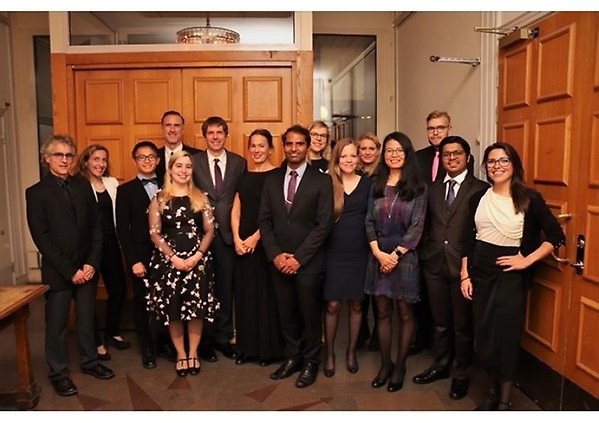
Projects
Immune cells have unique properties that make them ideally equipped to scan the environment and respond accordingly. However, our current understanding of the immune system is mainly based on the contributions of immune cells during disease, where they fight invading pathogens, kill cancer cells, or cause tissue injury during allergies or autoimmune disorders. If immune cells have important functions also during development, healing and regulation of organ function have up to now been largely overlooked.
Origin, recruitment and characterization of pro-angiogenic neutrophils during homeostasis and pathologic conditions
My laboratory has identified a subpopulation of neutrophils with proangiogenic properties. These proangiogenic neutrophils are recruited by VEGF-A to sites of hypoxia where they are important to initiate blood vessel formation. Distinct adhesion molecules are employed during recruitment of proangiogenic neutrophils from blood to tissue, making it possible to selectively target this population without affecting the main neutrophil population. We are now further characterizing the origin of these cells and how they are recruited to sites of hypoxia, as well as their functional role in models of peripheral ischemic disease, transplantation, tissue healing, and in cancer.
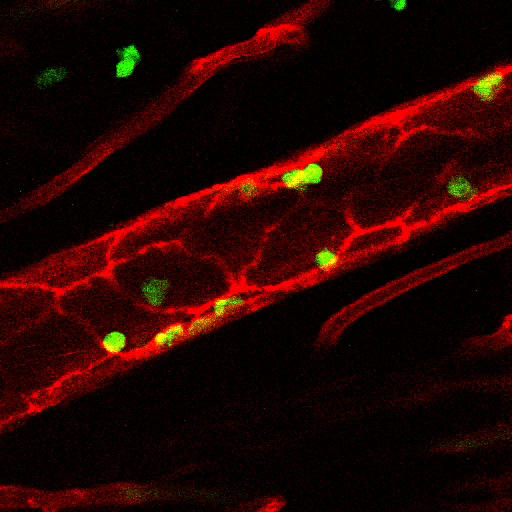
The role of macrophages in tissue restitution
Macrophages are tissue resident immune cells with functions beyond classic immunity. We have found that macrophages accumulate at perivascular positions around newly formed blood vessels at the site of hypoxia, where they are important for restoring blood perfusion.
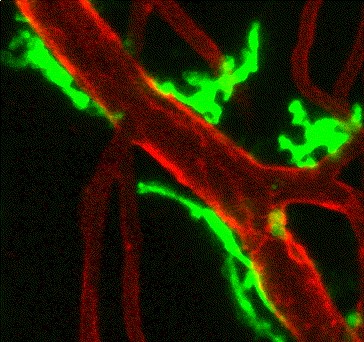
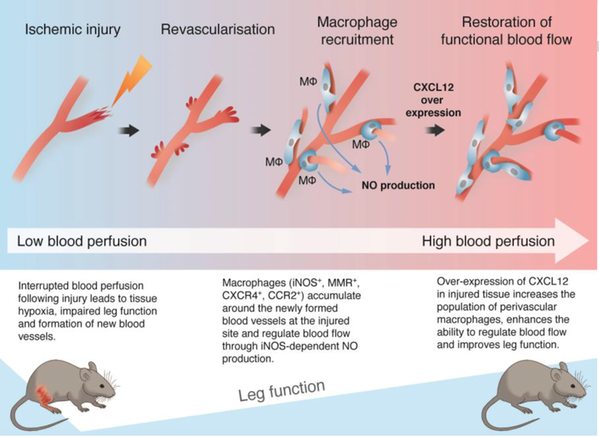
We have also demonstrated that macrophages are key for the healing of skin wounds, and uncovered means to therapeutically target this to accelerate healing. Based on these findings, the spin-off company Ilya Pharma was founded, which is developing drugs from its technology platform of lactic acid bacteria expressing different human therapeutic proteins.
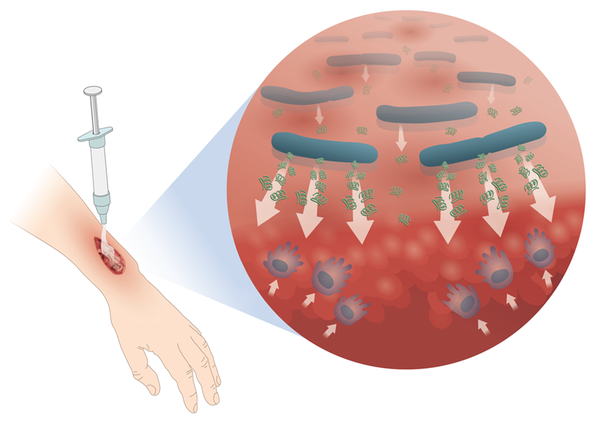
Parts of ongoing efforts in my lab are following up on these observations and investigate fate and functions of macrophages at the injured site, with the ultimate goal to identify means to accelerate healing and tissue restitution following injuries.
Gut-bacterial crosstalk
The gastrointestinal tract houses a massive amount of bacteria without developing inflammation under steady state condition. We are interested in understanding how the intestinal barrier and resident immune cells succeeds in keeping the bacteria at bay, and how the bacteria are influencing their microenvironment within the intestinal lumen. Further, we are investigating how addition of probiotics influence gut health. We recently revealed that Peyer’s patches, the lymphoid tissues of the intestinal mucosa, sense, enhance and transmit signals from certain probiotic bacteria, which increases the IgA production, shifts the microbiota into less dysbiotic and ultimately protects against colitis. We now attempt to further delineating the bacteria-immune cell crosstalk to reveal potential therapeutic strategies.
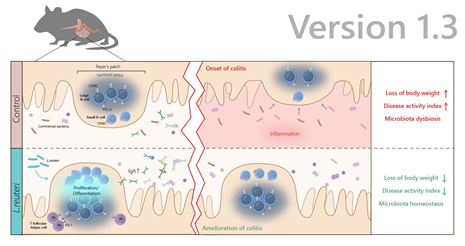
Immune cells in diabetes
Diabetes develops when blood glucose regulation fails as a result of reduced insulin secretion from the pancreatic islets or impaired peripheral insulin sensitivity, ultimately leading to reduced cellular uptake of glucose. Immune cells are involved in disease onset and progress in many different ways. We are part of the Uppsala Diabetes Center, and investigate the role of resident islet macrophages in islet development in newborn mice and their implications for islet long-term function.
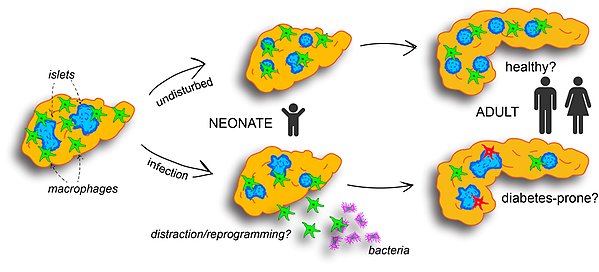
Publications
Corpora cavernosa fibroblasts mediate penile erection
Part of Science, 2024
Macrophages behave like mural cells to promote healing of ischemic muscle injury
Part of NATURE CARDIOVASCULAR RESEARCH, p. 625-626, 2024
Part of Nature Communications, 2023
- DOI for Correlates of protection and viral load trajectories in omicron breakthrough infections in triple vaccinated healthcare workers
- Download full text (pdf) of Correlates of protection and viral load trajectories in omicron breakthrough infections in triple vaccinated healthcare workers
Part of eClinicalMedicine, 2023
- DOI for Engineered bacteria to accelerate wound healing: an adaptive, randomised, double-blind, placebo-controlled, first-in-human phase 1 trial
- Download full text (pdf) of Engineered bacteria to accelerate wound healing: an adaptive, randomised, double-blind, placebo-controlled, first-in-human phase 1 trial
Part of Chest, p. 503-516, 2023
- DOI for OSA Is Associated With the Human Gut Microbiota Composition and Functional Potential in the Population-Based Swedish CardioPulmonary bioImage Study
- Download full text (pdf) of OSA Is Associated With the Human Gut Microbiota Composition and Functional Potential in the Population-Based Swedish CardioPulmonary bioImage Study
Part of Vaccines, 2022
- DOI for Duration of SARS-CoV-2 Immune Responses Up to Six Months Following Homologous or Heterologous Primary Immunization with ChAdOx1 nCoV-19 and BNT162b2 mRNA Vaccines
- Download full text (pdf) of Duration of SARS-CoV-2 Immune Responses Up to Six Months Following Homologous or Heterologous Primary Immunization with ChAdOx1 nCoV-19 and BNT162b2 mRNA Vaccines
Part of PLOS ONE, 2022
- DOI for SARS-CoV-2 induces a durable and antigen specific humoral immunity after asymptomatic to mild COVID-19 infection
- Download full text (pdf) of SARS-CoV-2 induces a durable and antigen specific humoral immunity after asymptomatic to mild COVID-19 infection
The anti-inflammatory peptide Catestatin blocks chemotaxis
Part of Journal of Leukocyte Biology, p. 273-278, 2022
- DOI for The anti-inflammatory peptide Catestatin blocks chemotaxis
- Download full text (pdf) of The anti-inflammatory peptide Catestatin blocks chemotaxis
Part of Journal of Inflammation Research, p. 4995-5008, 2022
- DOI for Chlorite-Oxidized Oxyamylose (COAM) Has Antibacterial Activity and Positively Affects Skin Wound Healing
- Download full text (pdf) of Chlorite-Oxidized Oxyamylose (COAM) Has Antibacterial Activity and Positively Affects Skin Wound Healing
Impact of SARS-CoV-2 infection on vaccine-induced immune responses over time
Part of Clinical & Translational Immunology (CTI), 2022
- DOI for Impact of SARS-CoV-2 infection on vaccine-induced immune responses over time
- Download full text (pdf) of Impact of SARS-CoV-2 infection on vaccine-induced immune responses over time
Part of Immunity, Inflammation and Disease, 2022
- DOI for Long-term SARS-CoV-2-specific and cross-reactive cellular immune responses correlate with humoral responses, disease severity, and symptomatology
- Download full text (pdf) of Long-term SARS-CoV-2-specific and cross-reactive cellular immune responses correlate with humoral responses, disease severity, and symptomatology
Part of Journal of Internal Medicine, p. 72-80, 2022
- DOI for Robust humoral and cellular immune responses and low risk for reinfection at least 8 months following asymptomatic to mild COVID-19
- Download full text (pdf) of Robust humoral and cellular immune responses and low risk for reinfection at least 8 months following asymptomatic to mild COVID-19
How can we optimize the development of drugs for wound healing?
Part of Expert Opinion on Drug Discovery, p. 93-96, 2022
Part of The Lancet - Infectious diseases, p. 943-945, 2022
Part of Pharmaceutics, 2022
- DOI for Accelerated Wound Healing in Minipigs by On-Site Production and Delivery of CXCL12 by Transformed Lactic Acid Bacteria
- Download full text (pdf) of Accelerated Wound Healing in Minipigs by On-Site Production and Delivery of CXCL12 by Transformed Lactic Acid Bacteria
Part of mBio, 2021
- DOI for Salmonella enterica Serovar Typhimurium Exploits Cycling through Epithelial Cells To Colonize Human and Murine Enteroids
- Download full text (pdf) of Salmonella enterica Serovar Typhimurium Exploits Cycling through Epithelial Cells To Colonize Human and Murine Enteroids
Symptoms and Functional Impairment Assessed 8 Months After Mild COVID-19 Among Health Care Workers
Part of Journal of the American Medical Association (JAMA), p. 2015-2016, 2021
Part of PLOS ONE, 2021
- DOI for An evaluation of a FluoroSpot assay as a diagnostic tool to determine SARS-CoV-2 specific T cell responses
- Download full text (pdf) of An evaluation of a FluoroSpot assay as a diagnostic tool to determine SARS-CoV-2 specific T cell responses
Perivascular macrophages regulate blood flow following tissue damage
Part of Circulation Research, p. 1694-1707, 2021
Part of Arteriosclerosis, Thrombosis and Vascular Biology, p. 988-994, 2021
Distinct B cell subsets in Peyer's patches convey probiotic effects by Limosilactobacillus reuteri
Part of Microbiome, 2021
- DOI for Distinct B cell subsets in Peyer's patches convey probiotic effects by Limosilactobacillus reuteri
- Download full text (pdf) of Distinct B cell subsets in Peyer's patches convey probiotic effects by Limosilactobacillus reuteri
Part of Journal of Pharmaceutical Sciences, p. 239-250, 2021
- DOI for Proteomics-Informed Identification of Luminal Targets For In Situ Diagnosis of Inflammatory Bowel Disease
- Download full text (pdf) of Proteomics-Informed Identification of Luminal Targets For In Situ Diagnosis of Inflammatory Bowel Disease
SARS-CoV-2 exposure, symptoms and seroprevalence in healthcare workers in Sweden
Part of Nature Communications, 2020
- DOI for SARS-CoV-2 exposure, symptoms and seroprevalence in healthcare workers in Sweden
- Download full text (pdf) of SARS-CoV-2 exposure, symptoms and seroprevalence in healthcare workers in Sweden
Erik Persson (1941-2020): a Remembrance
Part of Acta Physiologica, 2020
The discovery and development of topical medicines for wound healing
Part of Expert Opinion on Drug Discovery, p. 485-497, 2019
- DOI for The discovery and development of topical medicines for wound healing
- Download full text (pdf) of The discovery and development of topical medicines for wound healing
The Healing Power of Neutrophils
Part of Trends in immunology, p. 635-647, 2019
Part of Molecular Nutrition & Food Research, 2019
Part of Nutrients, 2019
- DOI for Dietary Fiber in Bilberry Ameliorates Pre-Obesity Events in Rats by Regulating Lipid Depot, Cecal Short-Chain Fatty Acid Formation and Microbiota Composition
- Download full text (pdf) of Dietary Fiber in Bilberry Ameliorates Pre-Obesity Events in Rats by Regulating Lipid Depot, Cecal Short-Chain Fatty Acid Formation and Microbiota Composition
High Resolution Intravital Imaging of the Renal Immune Response to Injury and Infection in Mice
Part of Frontiers in Immunology, 2019
- DOI for High Resolution Intravital Imaging of the Renal Immune Response to Injury and Infection in Mice
- Download full text (pdf) of High Resolution Intravital Imaging of the Renal Immune Response to Injury and Infection in Mice
Turning Up the Heat: Local Temperature Control During in vivo Imaging of Immune Cells
Part of Frontiers in Immunology, 2019
- DOI for Turning Up the Heat: Local Temperature Control During in vivo Imaging of Immune Cells
- Download full text (pdf) of Turning Up the Heat: Local Temperature Control During in vivo Imaging of Immune Cells
The neutrophil: one cell on many missions or many cells with different agendas?
Part of Cell and Tissue Research, p. 415-423, 2018
Perivascular macrophages regulate blood flow following tissue damage
Part of European Journal of Clinical Investigation, p. 44-45, 2018
Part of European Journal of Clinical Investigation, p. 78-78, 2018
Part of European Journal of Clinical Investigation, p. 79-79, 2018
Part of European Journal of Clinical Investigation, p. 79-79, 2018
Elucidating the dynamics and role of peri-vascular macrophages
Part of European Journal of Clinical Investigation, p. 82-83, 2018
Part of European Journal of Clinical Investigation, p. 83-83, 2018
Citrullinated histone H3 as a novel prognostic blood marker in patients with advanced cancer
Part of PLOS ONE, 2018
- DOI for Citrullinated histone H3 as a novel prognostic blood marker in patients with advanced cancer
- Download full text (pdf) of Citrullinated histone H3 as a novel prognostic blood marker in patients with advanced cancer
Part of Proceedings of the National Academy of Sciences of the United States of America, p. 1895-1900, 2018
- DOI for Accelerated wound healing in mice by on-site production and delivery of CXCL12 by transformed lactic acid bacteria
- Download full text (pdf) of Accelerated wound healing in mice by on-site production and delivery of CXCL12 by transformed lactic acid bacteria
The multitasking neutrophils and their involvement in angiogenesis
Part of Current opinion in hematology, p. 3-8, 2017
Vascular sprouts induce local attraction of proangiogenic neutrophils
Part of Journal of Leukocyte Biology, p. 741-751, 2017
Implanted biomaterials: Neutrophil-mediated vascularization
Part of Nature Biomedical Engineering, 2017
Targeting vascular and leukocyte communication in angiogenesis, inflammation and fibrosis
Part of Nature reviews. Drug discovery, p. 125-142, 2016
Part of PLOS ONE, 2016
- DOI for In Vivo and In Vitro Detection of Luminescent and Fluorescent Lactobacillus reuteri and Application of Red Fluorescent mCherry for Assessing Plasmid Persistence
- Download full text (pdf) of In Vivo and In Vitro Detection of Luminescent and Fluorescent Lactobacillus reuteri and Application of Red Fluorescent mCherry for Assessing Plasmid Persistence
Part of Acta Physiologica, p. 300-310, 2016
Part of American Journal of Pathology, p. 1094-1103, 2015
Part of Blood, p. 2016-2026, 2015
Part of Cell Transplantation, p. 263-276, 2015
Part of Acta Physiologica, p. 200-209, 2015
- DOI for Shb deficiency in endothelium but not in leukocytes is responsible for impaired vascular performance during hindlimb ischemia.
- Download full text (pdf) of Shb deficiency in endothelium but not in leukocytes is responsible for impaired vascular performance during hindlimb ischemia.
Physiological recycling of endogenous nitrate by oral bacteria regulates gastric mucus thickness
Part of Free Radical Biology & Medicine, p. 241-247, 2015

